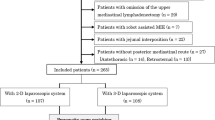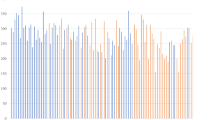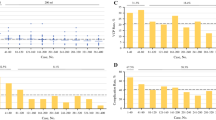Abstract
Background
To compare the perioperative outcomes from McKeown minimally invasive esophagectomy (MIE) when performed in three-dimensional versus two-dimensional visualization system, and investigate the learning curve of a single surgeon who implemented three-dimensional McKeown MIE.
Methods
A total of 335 consecutive cases (three-dimensional or two-dimensional) were identified. Perioperative clinical parameters were compared and cumulative sum learning curve was plotted. Propensity score matching was used to reduce selection bias from confounding factors.
Results
Patients in three-dimensional group were associated with more chronic obstructive pulmonary disease (23.9% vs 3.0%, p < 0.01). After propensity score matching (108 matched patients in each groups), this finding was no longer statistically significant. Comparing to two-dimensional group, significant improvement in total retrieved lymph nodes (28 vs 33, p = 0.003) was observed in three-dimensional group. In addition, more lymph nodes around the right recurrent laryngeal nerve were harvested in three-dimensional group than that in two-dimensional group (p = 0.045). However, there were no significantly differences were found between the two groups in terms of other intraoperative parameters (e.g., operative time) and postoperative relevant outcomes (e.g., lung infection). Furthermore, the change point in the cumulative sum learning curves for intraoperative blood loss and thoracic procedure time was 33 procedures, respectively.
Conclusion
Three-dimensional visualization system appears to be superior in performing lymphadenectomy during McKeown MIE to that of a two-dimensional technique. For surgeons proficient in performing two-dimensional McKeown MIE, the learning curve for a three-dimensional procedure appears to begin near proficiency after more than 33 cases.

Similar content being viewed by others
References
Tagkalos E, Goense L, Hoppe-Lotichius M et al (2020) Robot-assisted minimally invasive esophagectomy (RAMIE) compared to conventional minimally invasive esophagectomy (MIE) for esophageal cancer: a propensity-matched analysis. Dis Esophagus 33(4):doaa060
Li XK, Xu Y, Zhou H et al (2021) Does robot-assisted minimally invasive oesophagectomy have superiority over thoraco-laparoscopic minimally invasive oesophagectomy in lymph node dissection? Dis Esophagus 34(2):doaa050
Yamashita K, Mine S, Toihata T et al (2019) The usefulness of three-dimensional video-assisted thoracoscopic esophagectomy in esophageal cancer patients. Esophagus 16(3):272–277
Li Z, Li JP, Qin X et al (2015) Three-dimensional vs two-dimensional video assisted thoracoscopic esophagectomy for patients with esophageal cancer. World J Gastroenterol 21(37):10675–10682
Abbassi O, Patel K, Jayanthi NV (2021) Three-dimensional vs two-dimensional completely minimally invasive 2-stage esophagectomy with intrathoracic hand-sewn anastomosis for esophageal cancer: comparison of intra-and postoperative outcomes. Surg Innov 28(5):582–589
van der Kaaij RT, van Sandick JW, van der Peet DL et al (2016) First experience with three-dimensional thoracolaparoscopy in esophageal cancer surgery. J Laparoendosc Adv Surg Tech A 26(10):773–777
Kudo T, Oshikiri T, Takiguchi G et al (2021) Three-dimensional visualization system is one of the factors that improve short-term outcomes after minimally invasive esophagectomy. Langenbecks Arch Surg 406(3):631–639
Bao T, Li KK, Liu B et al (2022) Learning curve and associated prognosis of minimally invasive mckeown esophagectomy. Ann Thorac Surg S0003–4975(22):00200–00204
Guo W, Zhao YP, Jiang YG et al (2012) Prevention of postoperative chylothorax with thoracic duct ligation during video-assisted thoracoscopic esophagectomy for cancer. Surg Endosc 26(5):1332–1336
American Thoracic Society, Infectious Diseases Society of America (2005) Guidelines for the management of adults with hospital-acquired, ventilatorassociated, and healthcare-associated pneumonia. Am J Respir Crit Care Med 171:388–416
Zaninotto G, Low DE (2016) Complications after esophagectomy: it is time to speak the same language. Dis Esophagus 29(6):580–582
Low DE, Alderson D, Cecconello I et al (2015) International consensus on standardization of data collection for complications associated with esophagectomy: Esophagectomy Complications Consensus Group (ECCG). Ann Surg 262(2):286–294
Clavien PA, Barkun J, de Oliveira ML et al (2009) The Clavien-Dindo classification of surgical complications: five-year experience. Ann Surg 250(2):187–196
Chen L, Li B, Zeng L et al (2019) Three-dimensional vs 2-dimensional laparoscopic gastrectomy for gastric cancer: a systematic review and meta-analysis. Medicine (Baltimore) 98(49):e18222
Bao T, Zhao XL, Liu B et al (2022) Effect of pleural adhesions on short- and long-term outcomes after minimally invasive esophagectomy: a propensity score matching analysis. Surg Endosc. https://doi.org/10.1007/s00464-022-09687-9
Wilhelm D, Reiser S, Kohn N et al (2014) Comparative evaluation of HD 2D/3D laparoscopic monitors and benchmarking to a theoretically ideal 3D pseudodisplay: even well-experienced laparoscopists perform better with 3D. Surg Endosc 28(8):2387–2397
Tanagho YS, Andriole GL, Paradis AG et al (2012) 2D versus 3D visualization: impact on laparoscopic proficiency using the fundamentals of laparoscopic surgery skill set. J Laparoendosc Adv Surg Tech A 22(9):865–870
Acknowledgements
None.
Author information
Authors and Affiliations
Contributions
WG and TB conceived and designed the experiments. TB, Y-JW, K-KL, X-LZ, BL, X-DH, X-FX, and LZ recorded the follow-up data. TB and K-LL analyzed the data and wrote the manuscript.
Corresponding authors
Ethics declarations
Disclosures
Tao Bao, Ying-Jian Wang, Kun-Kun Li, Xiao-Long Zhao, Bi Liu, Xian-Dong He, Xian-Feng Xie, Liang Zhang, Kun-Lin Li and Wei Guo have no conflicts of interest or financial ties to disclose.
Additional information
Publisher's Note
Springer Nature remains neutral with regard to jurisdictional claims in published maps and institutional affiliations.
Supplementary Information
Below is the link to the electronic supplementary material.
Rights and permissions
Springer Nature or its licensor (e.g. a society or other partner) holds exclusive rights to this article under a publishing agreement with the author(s) or other rightsholder(s); author self-archiving of the accepted manuscript version of this article is solely governed by the terms of such publishing agreement and applicable law.
About this article
Cite this article
Bao, T., Wang, YJ., Li, KK. et al. Safety and feasibility of three-dimensional McKeown minimally invasive esophagectomy. Surg Endosc 37, 6908–6914 (2023). https://doi.org/10.1007/s00464-023-10172-0
Received:
Accepted:
Published:
Issue Date:
DOI: https://doi.org/10.1007/s00464-023-10172-0




